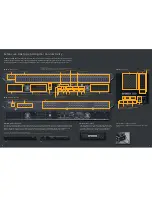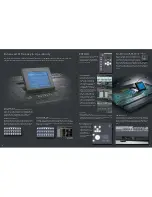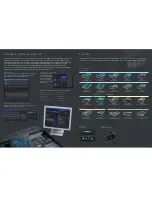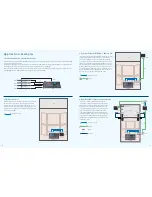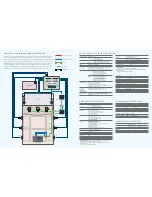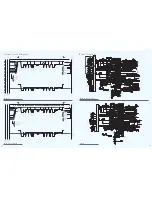
E n h a n c e d Fe a t u r e s a n d S c a l a b i l i t y
The PM5D V2* includes numerous refinements and
innovations that significantly improve both its operability and
functionality. Almost all of these have been implemented on
the basis of feedback from experienced professionals in the
field, and provide improved functionality and performance
that makes a difference in real-world applications. PM5D V2
also offers full compatibility with Yamaha’s new DSP5D Digital
Mixing System units can not only double or triple the I/O
capacity of the PM5D V2 console with seamless control
integration, but also function as high-performance remote
mixing engines and stage boxes connected to the console via
a single Cat-5 Ethernet cable.
* Owners of the original PM5D or PM5D-RH can download the version-2 firmware
update from the Yamaha Pro Audio website at:
http://www.yamahaproaudio.com/
Choose the Front End that Suits Your Needs
Customers have a choice of two front-end configurations. The PM5D V2 includes
48 XLR/balanced TRS analog mono inputs with manual mic preamps, plus
additional 4 stereo line level inputs. The PM5D-RH V2 includes 48 XLR analog
mono inputs with recallable mic preamps with 4 stereo inputs that will accept mic
level signals. The choice will depend on your needs and budget, and whether you
need to store and recall the analog gain settings in the same way as other
parameters. Whichever model you choose, you are assured of the best sound
quality available. Both superb mic preamps convey the most delicate nuances of
the input signal right down to the smallest details. In this brochure “PM5D V2”
refers to features common to both configurations, unless otherwise noted.
Easily Manageable Size and Weight for Touring or
Installations
On the surface the PM5D V2 may look like a streamlined 24-channel console, but
it is actually much, much more: a total of 130 input connections, simultaneous
mixing of up to 64 inputs to stereo or LCR stereo, and 24 mix buses with
extraordinary versatility, all with 500-scenes of total recall. Plus you have the
equivalent of several racks full of first-rate processing gear onboard (56 Gates, 92
Comps, 97 Delays, 12 GEQs, 8 units of SPX2000 class multi effects, and more).
Add advanced digital patching capability, sophisticated monitoring, surround
panning from 3-1 to 6.1, and a wealth of features that contribute to unprecedented
operational ease and efficiency. The fact that all of this is housed in a 950mm x
1551mm foot print console that weighs less than 98kg, powered by a 3U external
power supply that weighs only 10kg, is simply staggering. If you’ve been touring
with traditional equipment you’ll appreciate the dramatically reduced setup time
and effort required by this groundbreaking console. If you’re equipping an
installation you’ll love the reduced installation and maintenance costs, as well as
all the space you’ll save.
32-bit Internal Processing
The PM5D V2 will handle 24-bit/96kHz audio without compromise. You won’t
sacrifice channels or any other processing capabilities whether the PM5D is run at
44.1, 48, 88.2 or 96-kHz. Internal processing is all 32-bit (using 58-bit
accumulators) to ensure that absolutely no loss of audio quality occurs at any
point in the signal path.
High-capacity, Versatile Mix Performance
The PM5D V2 can accommodate a total of 130 input connections (48 channel
inputs, four stereo inputs, five 2 TR IN’s plus four mini-YGDAI slots), and can
handle up to 64 inputs simultaneously. The 64 input mixing channels are
configured by default as 48 mono input channels, 4 stereo inputs, and 4 stereo
effect returns. By utilizing the internal patch bay and expansion slots you can
instantly scene-switch between totally separate stage setups. In terms of bus-
routing capability you have 24 mix buses that can function as submasters or
auxiliary sends, in addition to the stereo A and B (or LCR) and CUE buses. There’s
also an 8- output mix matrix that is invaluable for setting up submixes for a variety
of applications. Any of the input channels, mix buses, and matrix buses can be
assigned to the console’s 8 DCA faders for extraordinarily flexible group control.
DSP5D Digital Mixing System Compatibility for
Doubled or Tripled Capacity
If you need more I/O capacity and processing power than the PM5D V2 provides
alone, you can add Yamaha DSP5D Digital Mixing System units that provide
essentially all the functionality of a PM5D-RH V2 in a rack-mountable unit that can
be seamlessly controlled from a PM5D (RH) V2 console. Up to two DSP5D units
can be used with a single PM5D V2 console. A PM5D V2 plus one DSP5D gives you
a total of 96 mono and 16 stereo input channels, while adding two DSP5D units to
a PM5D V2 provides 144 mono and 24 stereo input channels to comfortably
handle large-scale applications. And of course your processing power is doubled
or tripled, respectively.
In terms of I/O capacity and processing capability a single DSP5D offers:
■
48 mono and 4 stereo inputs.
■
24 Mix buses (cascaded to the PM5D V2 mix buses).
■
8 Matrix buses.
■
24 Omni Outputs.
■
Full channel functionality: gain, EQ and filters, dynamics, sends.
■
8 effect processors and 12 graphic equalizers.
■
2 mini-YGDAI expansion card slots.
■
Full compatibility with DSP5D Editor computer software.
■
The ability to function as a remote DSP processor and I/O expansion
unit via the DCU5D Digital Cabling Unit. The ability to function as a
remote DSP processor and I/O expansion unit via the DCU5D Digital
Cabling Unit.
Like the PM5D itself, all analog inputs and outputs are directly accessible via
standard XLR type connectors. After a few simple connections the DSP5D becomes
an integral part of the PM5D console, and can be controlled from the PM5D
control surface in the same way as the internal functions. So although you have
significantly upgraded the system, you can simply plug in your sources and output
devices and use it right away without having to work through another learning
curve. You can directly connect the DSP5D to a PM5D via standard cascade cables
if they are to be used in relatively close proximity. But if you want to use the
DSP5D as a remote I/O with powerful DSP function the DCU5D Digital Cabling Unit
lets you locate the DSP5D as far as 120 meters* from the PM5D console,
connected only by one Cat-5 Ethernet cable. This dramatically reduces cabling
requirements while maintaining solid audio and control reliability over extended
distances.
* Refer to http://www.ethersound.com/technology/compatibility.php
DSP5D and DCU5D utilize EtherSound technologies. But because bandwidth is fixed exclusively for DSP5D and
DCU5D, they cannot be controlled by ES monitor.
PM5D V2
PM5D-RH V2
DSP5D
DCU5D
4
5







